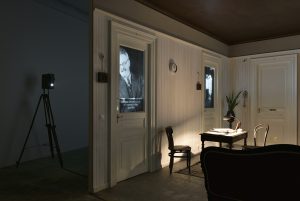While in Paris, I explored the galleries in the Marais situated within the 3rd and 4th arrondissement. After talking to the women working at the Gagosian Gallery, they recommended the Marian Goodman gallery, a favorite gallery within the Paris art industry.

For his solo show, O Sentimental Machine, William Kentridge found inspiration from a piece of found footage of Leon Trotsky, Marxist theorist and Soviet Politician, giving a speech in response to being exiled from Turkey. From this piece of found footage, Kentridge made a five-channel video installation in the basement level of the gallery with accompanying drawings on the ground floor. These drawings in a sense represented Kentridge’s attachment and emotional exile from Paris in relation to Trotsky’s exile from Turkey.
The five-channel installation was comprised of an office set design reminiscent of the Soviet nation-state with four doors with clear mosaic glass windows. Through these windows four projections shined through distorted by the design of the glass. The fifth projection projected onto a screen in the middle of the set adjacent to an office table still warm from the presence of a missing secretary complete with an illuminated table light. When one approaches the installation, the first thing one sees is the construction of the piece and the inevitable distanciation the viewer can have to the piece. Wooden beams and digital projectors affixed to very old projector tripods dominate one’s view of the room. As one walks closer into the dark room, one is transported to Soviet USSR. Four channels of sound collide, compliment and contrast one another.
One channel of video is the said video of Leon Trotsky’s speech with English subtitles phasing in and out. Across from this channel is the same speech without subtitles at a staggered time. Two channels adjacent to these doors is found footage of Bolshevik marches, the Tsar on a swimming holiday, as well as shot imagery of the Bosphorus. The fifth channel in the middle of the room is a short film made by William Kentridge as Leon Trotsky and his secretary, the missing figure from the installation, enacting the general thesis of the piece, said by Trotsky himself: humans are “sentimental but programmable machines.” To Trotsky, humans have programmable qualities that can be quantified, edited edified and inherited onto future generations.

Many Soviet thinkers were concerned as to what would happen to imperfect people in a perfect society. To them, emotions can be controlled, removed, and hardwired to become perfect beings or in a sense, machines. One emotion, or experience, Trotsky has said disrupts the human machine is the experience of falling in love which, to Trotsky, makes the human unreliable and dysfunctional in terms of hardwiring.
Kentridge’s film in the center of the installation reflects Trotsky’s opinions on the programmable nature of humans. In this film, the secretary and Trotsky view their reflections at a slower pace than real time. Their reflections cannot complete the same tasks in an identical manner and fail to become perfect. As the film progresses, Trotsky becomes a machine composed of projector sticks and a megaphone as a head. Simultaneously, the channels adjacent to this one become further submerged in water.
It’s undeniable this installation has topical meanings in relation to the American presidency and the, just now completed, French election. The world as a whole is in a fragile political climate determined by Conservative insurgency countered by radical opposition. Can calls for action be effective or will they be submerged under the water of Conservative politics or media as a whole? Or is Kentridge saying that old Communist modes of thought regarding the transformation of imperfect bodies into mechanical beings an incomplete thought.
Trotsky’s words are full of contradictions in the present since although his speech questions the ethics of displacement including deportation and exile from countries, an obviously topical subject, his philosophy also points toward perfection of humans in a mechanical form. My first question is how one would quantify perfection and create standards for achieving this goal. Secondly, which populations of people would be creating and implementing these standards?
The whole installation is seeing a reflexive staging of Trotsky or a distanciation on the words of a political figure. Concurrently, the warm absence of the secretary’s desk also implies the voices excluded from conversations about politics. It has been said that Trotsky’s secretary was a crucial factor in Trotsky’s success beyond her job description. Although Trotsky’s words has merit even in present day, he is a human full of contradictions. Humans can never be machines because the function of the machine would automatically fail in the context of human error and contradictions. Trotsky can be both progressive and conservative in his politics and reaffirm his status by reaffirming the status of those who are marginalized.
Kentridge’s installation as well can be both reflexive and escapist. Once one sits in the chair within the office, it’s difficult to leave the installation since one feels transported to another time. Except all of the issues from that time have remained fixed throughout history.
The primary channel of the installation can be viewed at this link: https://vimeo.com/185640053